The Network 4
The Network 4 was a classroom networking system sold by Radio Shack that was popular in computer labs in the mid-1980’s. It allowed one computer used by a teacher to be connected to up to 63 student computers. The Network 4 was based around the TRS-80 Model 4, well after MS-DOS computers became more common. It was probably one of the biggest reasons the TRS-80 Model 4D remained in the Radio Shack catalog until 1990.
Education sales
In the early days of microcomputers, schools were viewed as a major market for computers. The Radio Shack Education Division, formed in 1980, aggressively promoted the use of computers in schools. In 1985, they stated that “Radio Shack is the leading marketer of microcomputers to schools, with more TRS-80 computers in America’s schools than any other brand.”
Radio Shack had been pushing the idea of connecting computers in schools since 1980 under the name “TRS-80 Network”:
A TRS-80 Network lets you implement a shared learning system — connecting non-disk student stations to the teacher’s disk, or “host” computer.
The Network 4 was Radio Shack’s fourth “TRS-80 Network” product. The earlier products were:
- The Network I Controller, introduced in 1980, allowed sixteen Model I or Model III computers to be connected using the cassette port.
- The Network 2 Controller replaced the Network I in 1981. It also used the cassette port, although at a faster speed, and allowed sixteen Model I, Model III, Model 4, Color Computer, MC-10, or Model 100 computers to be connected together.
- The Network 3 Controller, introduced in 1983, allowed sixteen Model III and Model 4 computers to be connected using RS-232 cables. The networking was more advanced than the Network 2 Controller, allowing individual files to be transferred instead of a single file transferred to all computers.
The Network 2, Network 3, and Network 4 had different applications and were all sold simultaneously.
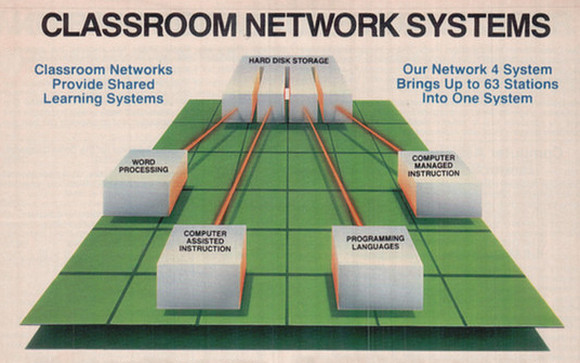
From a 1985 Radio Shack catalog
The Network 4
The Network 4, introduced in 1985, allowed even more computers to be connected in a computer lab. Here is a description from a 1985 advertisement:
The Network 4 Shared Learning System adds flexibility and economy to your computer lab or classroom. Using a twisted-pair cable, the Network 4 lets you connect up to 64 non-disk Model III or Model 4 student stations to a central host computer with a hard disk drive. The student stations can then share hard disk files, each station operating virtually as a stand-alone system. Each user can quickly access a set of teacher-designated programs and data files from the hard disk, information can be sent from station to station without using the hard disk, and reports can be printed on a printer at the host computer.
Although Radio Shack never mentioned the fact in their catalogs, the Network 4 was actually an implementation of Corvus Systems Omninet network. Omninet was an early networking standard that was designed to compete with the more expensive and bulkier Ethernet networks available at the time. Corvus sold Omninet cards for the Apple II and the IBM PC, among other computers. This meant that it was possible to connect non-TRS-80 computers to a Network 4 system, although I don’t know of anyone who actually tried to do that.
The Network 4 Host
The host (teacher computer) for the Network 4 was always a TRS-80 Model III or Model 4. The TRS-80 host needed an interface to the Network 4 system, which was the Model III/4 Network 4 Upgrade Kit (catalog number 26-1136). This kit, which cost $299.95 (not including required installation), converted a disk-based Model III or 4 to a Network 4 host. Also required for a host was the Network 4 Operating Software (catalog number 26-2773), which cost $230.00. This software, which ran on top of Model III TRSDOS 1.3, allowed the student computers to access the host hard disk drive and printer.
The host Model III or 4 was required to be equipped with a hard drive. This made it one of the few Model 4 applications that actually required a hard drive, rather than just worked better with one. For most applications, the host computer was also required to have a printer.
The Network 4 Student Stations
Each individual student computer could be a Model III, Model 4, or (later) a Tandy 1000. (Curiously, Radio Shack never offered any way for the TRS-80 Color Computer to work with the Network 4.) Each student computer also needed to have a Network 4 interface. Existing Model III and Model 4 computers could be upgraded using the Student Station Upgrade Kit (catalog number 26-1137) which cost $299.95 (not including required installation). As an alternative, Radio Shack sold the Non-Disk Model 4 Student Station (catalog number 26-1058) for $1099.00, which was a Model 4 already equipped with the Network 4 hardware.
In the 1987 catalog, Radio Shack expanded Network 4 support to their MS-DOS Tandy 1000 computers. The Tandy 1000 Network 4 Interface (catalog number 25-1008) cost $299.95. Tandy 1000 EX or HX computers could be upgraded using the PLUS Network 4 Interface (catalog number 25-1019) for $299.95. Both interfaces were plugin cards and didn’t require professional installation. Any Tandy 1000 stations on the network needed to run the Network 4 Operating Software for Tandy 1000 Stations (catalog number 26-2772), which cost $170.00.
For cabling, Radio Shack sold a 100-foot trunk cable (catalog number 26-1218) for $16.95, a 500-foot trunk cable (catalog number 26-1214) for $69.95, and a 1000-foot trunk cable (catalog number 26-1121) for $119.95
An Active Junction Box (catalog number 26-1255) was required if the system expanded to more than 32 stations or if the cable length was more than 1000 feet. The Active Junction Box cost $199.95.
The End
Although successful initially, Omninet networking never became very popular. The cost and implementation problems with Ethernet networks were soon addressed, and Ethernet became the dominant network standard that it is today.1 Corvus Systems went bankrupt in 1987.
Radio Shack never sold a product to allow the Tandy 1000 to act as Network 4 host. This meant that every Network 4 had to have a Model 4 as host, even if all the other computers on the network were MS-DOS Tandy 1000’s. This also meant that Radio Shack had to continue to sell the Model 4 as long as they sold new Network 4 systems or schools maintained existing ones.
In the 1990 Radio Shack catalog, Network 4 was replaced by the SchoolMate network. SchoolMate was an MS-DOS system (based around DeskMate) which ran on an Ethernet or ARCNET network. Probably not coincidentally, the 1990 catalog also marked the final appearance of the TRS-80 Model 4D.
-
Curiously (and unfortunately), Ethernet was one of the few networking schemes that Radio Shack never offered for their own computers. ↩︎
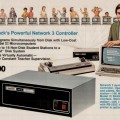
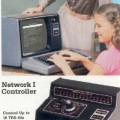
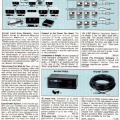
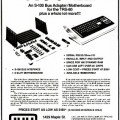










Steven Hirsch says:
I have a Network 4 client station kit, but have never been able to find any of the software or documentation. Someone paid a silly amount on eBay for a binder and diskettes earlier this year, but apparently kept it to themselves.
mike freeman says:
i have original masters of network 4 for use with tandy hard drive and corvus hard drives.
a compay called FPS servies developed it for tandy and corvus
tandy used trs dos corvus used newdos 80
michael